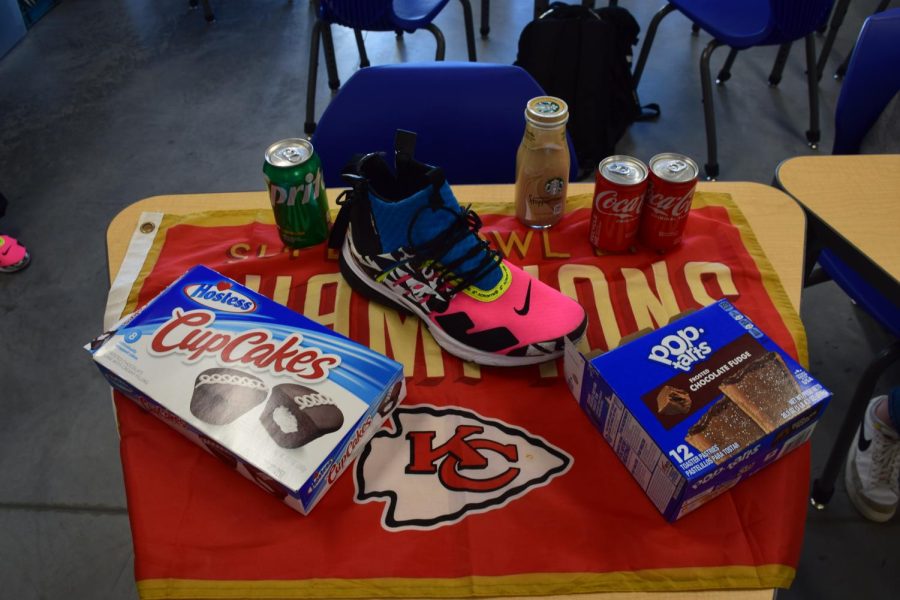Super Bowl or Super Buy?
Commercials dominate Super Bowl discussions
Brand logos and names abound celebrating the Kansas City Chiefs berth in the 2023 NFL Superbowl. Brands make use of the most viewed sports event of the year to advertise their products.
February 23, 2023
On February 12th, all of the nation gathered on their couches to watch the Kansas City Chiefs and the Philadelphia Eagles battle it out in the most highly anticipated football game of the season. Except, not really. Statistics show that 43% of viewers tune into the Super Bowl to watch the commercials. Are these ads beginning to supersede the importance of the big game, and what impact do they leave?
There are a few categories of approaches that brands take when advertising during the Bowl: the celebrity endorsements, the 30-second movies, the popular culture allusions, the yearly repeats, the heartstring tuggers, the close-up food shots, the agendas and the brand-new concepts. Just like any platform, viewers gravitate towards certain categories more than others.
Faculty member Ron Young says, “One of the most influential was the Apple commercial. It was based on 1984. The girl comes in in the track uniform, carrying the sledge hammer and then throws the sledge hammer at the screen to indicate the breaking of traditions from the old computer industry to the new industry.”
This year, Avocados From Mexico’s Adam and Eve commercial, Popcorners’s Breaking Bad and Doritos’s triangle trend engaged crowds while the Cenex teacher’s motorcycle, Peacock’s Poker Face, and Priceline’s inflatable child failed to impress. The varying success depends on the use of resources and execution of the advertisement.
Young, an established football superfan, says, “There are personalities that affect and bring people to watch that particular commercial. The Doritos commercial from a couple of years ago that had the rapper that was dressed up as a cowboy, you still see that every once in a while.”
Faculty member Haley Bajorek remarks on a missed opportunity: “I love Serena Williams, but they marketed her wrong this year. She was in way too many alcohol ads and was so serious in all of them.”
Controversy in the world of advertising is nothing new. By investing in a Super Bowl ad, companies spend millions to put their product in front of the eyes of America. In turn, these brands open themselves up to feedback, criticism and scrutiny. Religious organization He Gets Us spent millions of dollars to promote Christianity, leaving many questioning whether the investment was a necessary or effective approach. In months preceding the Bowl, M&Ms introduced a new female character to their lineup, receiving criticism claiming the brand was too radical.
Young explains the impacts: “Mars is wanting to support women, women in business and women in life. Others are taking it as a societal conflict.” This resulted in all the characters being ditched for spokeswoman Maya Rudolph.
Due to the extravagant nature of Super Bowl ads, some viewers end up discussing the promotions more than the game. Players put in innumerable hours of training, coaches plan and research as much as they can and teams fight through the entire season to play in the biggest game in the nation, so to imagine a thirty-second clip of a dancing Miles Teller overshadowing the event is, needless to say, startling. That said, Seabury football enthusiasts aren’t too worried.
Eighth grader Lucien Brockhoff, a football player himself, says, “The commercials do distract, but not in a bad way. It just brings more people in and more fans.”
Ninth grader Max Fagan concurs: “Football’s kind of a confusing sport if you don’t really know how to play it. I get it if some people just watch it for the commercials,” he says.
On the other hand, Bajorek points out larger scale issues: “There’s a question around the way we view sports, the way we commercialize and turn them into consumer activities that go beyond just cheering for the home team,” she says.
Though the commercials grab the attention of many viewers, nothing overshadows the events and results of the game. The Super Bowl is much bigger than a football game; it is a celebration encompassing all of the virtues of football, bringing both fans and those who don’t watch together. It is what young players aspire to be a part of, and what old players reminisce about.
“Even if you don’t play football, even if you don’t care for football, you understand the comradery of a sport, it’s something everyone connects to,” says Bajorek.
“Every football player wants to go to the Super Bowl someday, get a ring, or not even win there, [and say], ‘I was in the Super Bowl,’” says Fagan.
